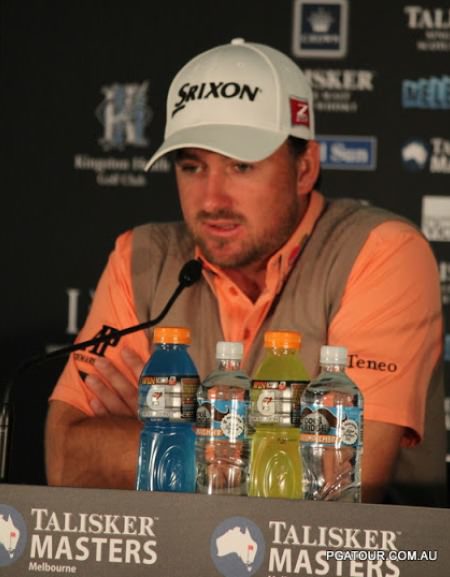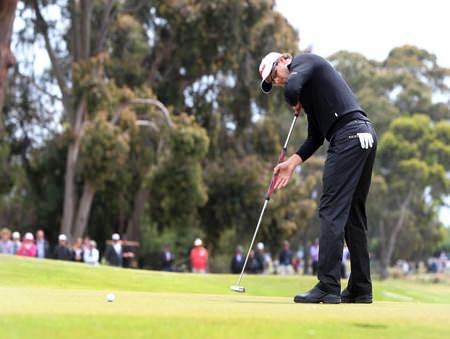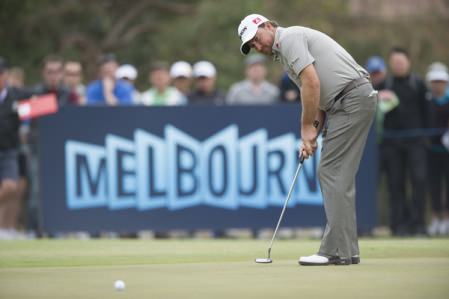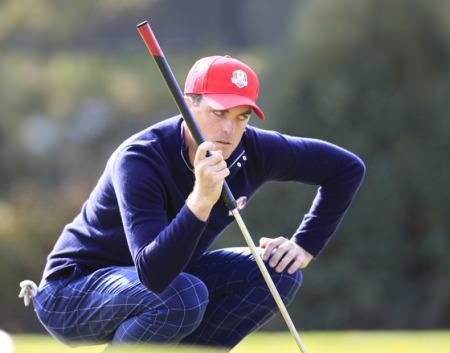McDowell and Poulter say anchoring ban overdue
 Graeme McDowell speaks in Melbourne before the Taliker Masters. Picture courtesy pgatour.com.auGraeme McDowell could have won two majors this year but walked away empty-handed as men anchoring long putters lifted trophies in the US Open and The Open.
Graeme McDowell speaks in Melbourne before the Taliker Masters. Picture courtesy pgatour.com.auGraeme McDowell could have won two majors this year but walked away empty-handed as men anchoring long putters lifted trophies in the US Open and The Open.
Did his putting cost him? Who knows. Is he happy about the advent of anchoring? Not in the least. Like Ian Poulter, who was also asked for his opinion on a possible ban on anchoring long putters before this week’s Talisker Masters in Melbourne, McDowell believes anchoring is inherently wrong and should have been outlawed back in the last 80s.
Not only that, he says USGA boss Mike Davis has told him that research shows that long putters anchored to a player’s body give them an edge under pressure.
With 14-year old Chinese prodigy Guan Tianlang recently using a long putter to become the youngest player to qualify for the Masters, the topic is hot news again.
“Young kids, the short putter is something that they very quickly throw in the corner of the room and they get their belly or long putter out,” said McDowell, who will partner long putter user Adam Scott in the first two rounds of the Talisker Masters in Melbourne. “I think that’s wrong.
“I heard a stat to the effect that 25-30 per cent of college kids in the United States are using oversized length putters. That’s kind of a shocking number.”
McDowell said the USGA has research showing that long putters made it easier to putt under pressure.
“They’re convinced the research has shown that under pressure on a Sunday afternoon the long putter just kind of takes one extraneous movement out of the putting stroke,” McDowell said at Kingston Heath.
“It just makes it physically easier to stroke the putter when the nerves are there (and) I think we should be levelling the playing field (by banning it).
“I think it’s probably something they’re disappointed in themselves that it’s got to this point. They probably should have nipped it in the bud many, many years ago.”
Poulter, who is defending his Australian Masters title, would not call anchoring cheating. But he was clear about what should be done.
“Ban it. End of story,” the Englishman said. “I mean, don’t anchor the butt end of the club. It’s simple right?”
He refused to be drawn on whether use of anchored putters was effectively cheating but pointed out that the problem is rapidly growing.
“I’m not going to go into that. You’re not going to get me to say whether people are cheating or not,” Poulter said. “The fact is that they’ve opened up a can of worms and it’s only become an issue because so many people have actually converted to it.
“They need to make a decision to let us all know what’s happening.”
On Guan, he added: “That’s the problem they face because they allowed it to happen in the first place. It should have been stamped out a while ago.”
The entire debate was summarised nicely by Gary Player before the Senior Open at Turnberry just days after Ernie Els’ captured his fourth major at Royal Lytham and St Annes:
And in fairness, this is what I’ve always said, that nerves are such an integral part of the game, and repeating what I said the other day, when you hit the long putter or the belly putter, straightaway you’re reducing nerves by 20 per cent. And that’s a shame. Because coming down the last few holes, this is what determines who wins, course management. You don’t suddenly start changing your swing. You’ve got the same swing. But it’s the course management and the nerves. And once you anchor, once you anchor, you’re taking away a large percentage of nerves. But Ernie himself said in the Mail yesterday, they shouldn’t have it. But I’ve been saying it for years.
Q. Do you think the difference between the chest and the belly‑‑
GARY PLAYER: Pretty much the same. Because once you anchor‑‑ (demonstrating). Now if you’re here, look at the margin of error you have with your hand anchored. When you’re anchored here, you can’t break down. The right hand doesn’t break down. Here, I’m out trying to stop breaking down, but if you anchor like that, you can’t break down, because it’s anchored. To me, it’s a tragedy.But I don’t think they should stop it. See, this is the one disagreement I have with the R&A, and I’m a big fan of the R&A, they say it’s the same game and I say it’s a different game. Go watch Tiger Woods tee off, go watch these guys tee off, it’s not the same game at all. They use different clubs. They use different balls. They say they are using the same ball; no, they are not. They are using the same clubs; no, they are not. They are not using the same clubs. These guys have got longer shots and these guys have got balls that have different flights. Let the amateurs have all of the technology and let them use the long putter and let them do what they like.
But professional golf, they are going to have to make ‑‑ I give you a guarantee they will make the long putter and the belly putter will go, and I will guarantee that in time, the ball will be cut back 40 yards or so. And if they don’t, if these people don’t, they will look back at history and say, why did they not do it. Because I tell you, I’ve seen guys come out hitting the ball over 400 yards now time and time and time; every week I see somebody hit it 400, things we never ever dreamt of. The ball is going so far, things we thought we would never see.
Actually, we are in our infancy now with golf. Everybody finds that hard to believe. Because I am seeing these guys that are seven‑foot tall starting to come to golf. We’ve never seen anybody‑‑ have you ever seen a seven‑foot man play golf? Never in your life. You’re going to have to have a 48‑inch driver‑‑ (Inaudible.) You might as well tell Tiger Woods he’s going to use a 25‑inch driver. So they have to change it. They have to. They have to.
I’ll give you a guarantee, in ten years’ time, you go to St. Andrews, and they will drive nine greens. They will drive nine holes. There’s a guy in Canada, who can drive nine par 4s. First tee, hits driver, every green.
So we’d better start making preparations right now, because it’s killing the game, because everybody is spending money on lengthening the golf courses, using more water, more fertilizer, more machinery, oil going at a hundred dollars a barely, making undulating greens, putting deep bunkers in. Now they are going to go back to play in bunkers, the pros can’t get out. You see what happens.
So now that’s just a minor example of what’s happening around the world. So the members are resigning. And the ones that are staying on‑‑ I know this for a fact because we design golf courses around the world, and they are too long. How long do you think it takes to play a round of golf? You go to New York or these big cities today and it’s an eight‑hour day, you leave home, an hour in the traffic, an hour back, and it’s a six‑hour round. Even now, Pro‑Ams are all five hours. We are going the wrong way.
Does anybody think I’m wrong? It’s logic, isn’t it. You can’t argue against logic.
Q. Inaudible.
GARY PLAYER: It exact down to nerves, but when you have that anchor, you’re taking away a large percentage of those nerves, a hell of a large percentage. If you don’t have those hands, they become a little bit twitchy. Why do you think guys go for these putters? That’s the question you’ve got to ask yourself. Why do they go? Adam Scott couldn’t putt with two hands. He’s a dreadful putter. He’s always had a great swing, wonderful striker. Nobody has a better swing than Adam Scott. They go to these putters for a reason.





